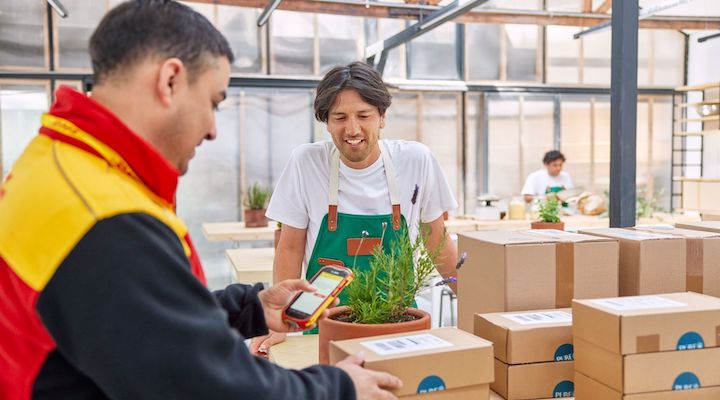With shipping rates climbing, retailers today are far less likely to be offering free delivery with purchases to encourage purchases – but they can still attract customers by offering delivery options to suit their budgets.
Denise McGrouther, VP, MD of DHL eCommerce Australia, says retailers are learning that not every consumer requires their purchase to be delivered as soon as possible – especially if they can pay less for shipping, they are willing to wait four to six days instead of two.
DHL eCommerce’s largest market for shipments from Australia is New Zealand where fashion is dominant, followed by the US where there is strong demand for cosmetics (especially tanning products) and swimwear.
DHL eCommerce is a relatively new division of DHL, formed in 2019, effectively replacing the old DHL Global Mail. It operates as an independent division, offering online retailers in Australia an affordable, reliable service for exported goods.
“Logistic costs for retailers have significantly increased – they are paying a lot more to send their parcels now than they ever have before, due to rising costs, especially in Europe,” explains McGrouther, explaining why offering free shipping no longer makes commercial sense.
“We advise retailers to ask their overseas customers if they need their purchase in two days, or if they can wait four to six days to get it. We see that where our retail customers are giving their clients a choice to pay a premium for express shipping, or less to have it shipped by standard option, a lot of customers opt for standard, they are not always looking for the faster option.
“We find that as long as their customers get their new dress before the following weekend, they’re happy to wait. And if they’re paying less for shipping, they are even happier,” says McGrouther.
“We see the demand for the standard shipping option increasing.” Part of that comes down to how much better-performing mail service companies have become compared with, say, five years ago she says. Standard shipping has evolved into a sophisticated service. For some key routes, the company has automatic proof of delivery, where couriers take photographs of delivered parcels and add them to the online tracking system visible online or by phone app. “Standard delivery has come a long way.”
DHL eCommerce’s fashion shipment volumes were up by 16 per cent last December and over the first fortnight of January by 20 per cent.
“Given the current economic climate we are in, it was quite surprising that volumes were so strong. We were especially amazed with the appetite for Australian swimwear which in the US is booming. US consumers want that Bondi or Byron Bay lifestyle and they want it now. The demand is high at the moment for that type of fashion.”
Asked what her advice would be to online retailers looking to commence deliveries offshore, McGrouthershared five key points:
Harness the power of partnerships
Firstly, partner with logistic experts – “you’ll be surprised how much they can help you”.
“The advances in technology are amazing for online retailers, they no longer need to have everything figured out by their own IT departments. I find that a lot of online retailers tend to work in their own little ecosystem and wonder how their competitors are managing logistics.
“It’s better if they work with experts like DHL or Starshipit and absorb all that expertise, then look around and ask questions. Like, why is retailer X offering four to 10 days delivery into the US and we are offering two days? Speed is not always the answer. It’s all about asking the questions of your shipping partner.”
Tracking is crucial – and be sure it is accurate
Managing expectations is essential, advises McGrouther. Giving your customers access to tracking information gives them peace of mind. But make sure it is set up to be accurate – and at your checkout be sure your shipping timetable promise is accurate.
“If the customer is told that their parcel will be delivered in four to eight days, they’re happy. But if that shipment doesn’t arrive by day eight, the consignee will follow up straightaway wanting to know where it is. If your customers don’t see a tracking update over four or five days, your customer service team will be flooded with enquiries. So you must ensure that the delivery service provider you choose to work with is giving frequent tracking updates and keeping the customer informed.
“Keep the consignee up to date so everyone knows what to expect and there are no surprises. The more the consignee is informed, the happier they are and the more likely you’ll earn repeat business.”
Make sure you have multiple shipping options
While many customers will be happy to wait six days to receive an item, some want their goods delivered as quickly as possible. So be sure to give them that option and don’t be shy to add a price premium.
Keep your packages as small as possible
While most of DHL eCommerce’s clients use satchels they still need to consider how to optimise the size of their shipped package. “Why put a phone case in a shoebox? You are paying for that box, not for the 200gm weight of the product inside.
“Consumers want that as well. They don’t want a lot of excess packaging they have to dispose of.”
Ask customers what packaging they want
McGrouther says a lot of Australian retailers are catching on to asking their customers what type of packaging they require. While you might want “all the bells and whistles” for a product being shipped as a gift if it is for personal use, many customers prefer simple, sustainable packaging, so be sure to give them the option at checkout.
A growing international trend is for durable products to be shipped in outers – like satchels – without any additional packaging from within the warehouse. But she warns that sustainable packaging “may come with an asterisk”.
“Sustainability is a hot topic, but you must be very careful. There are concerns that certain claims may be seen as greenwashing. It can be very complex.”
CTA goes here. For more information about how DHL eCommerce can help your cross-border online shipping, visit here.






